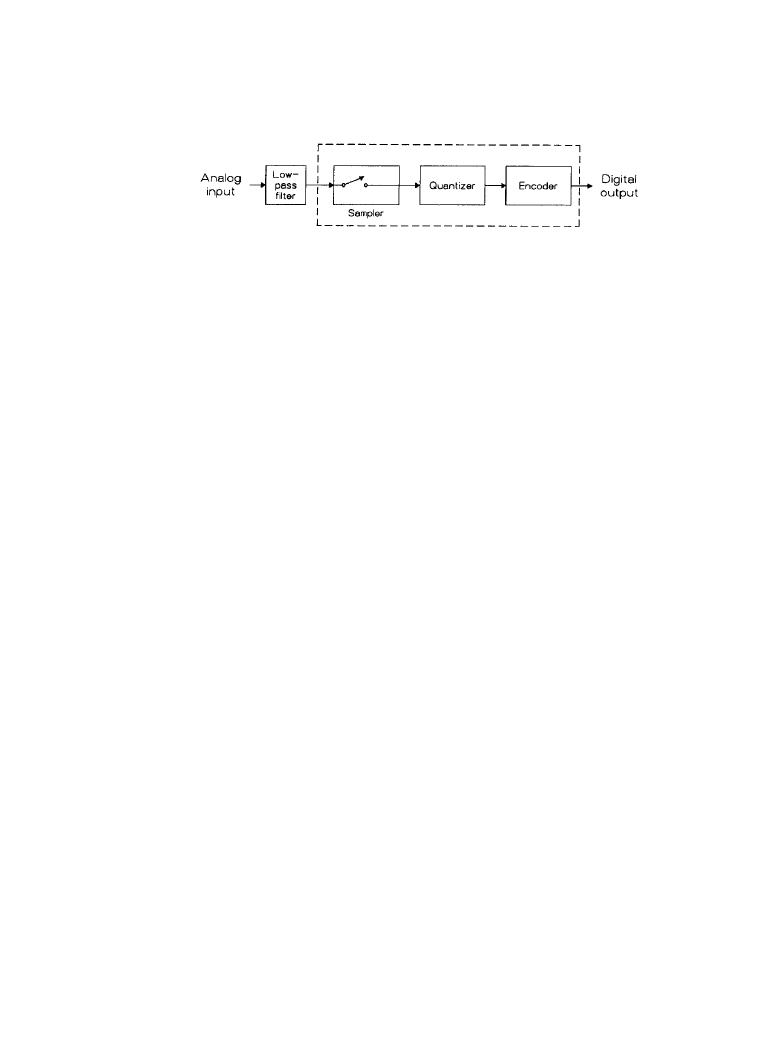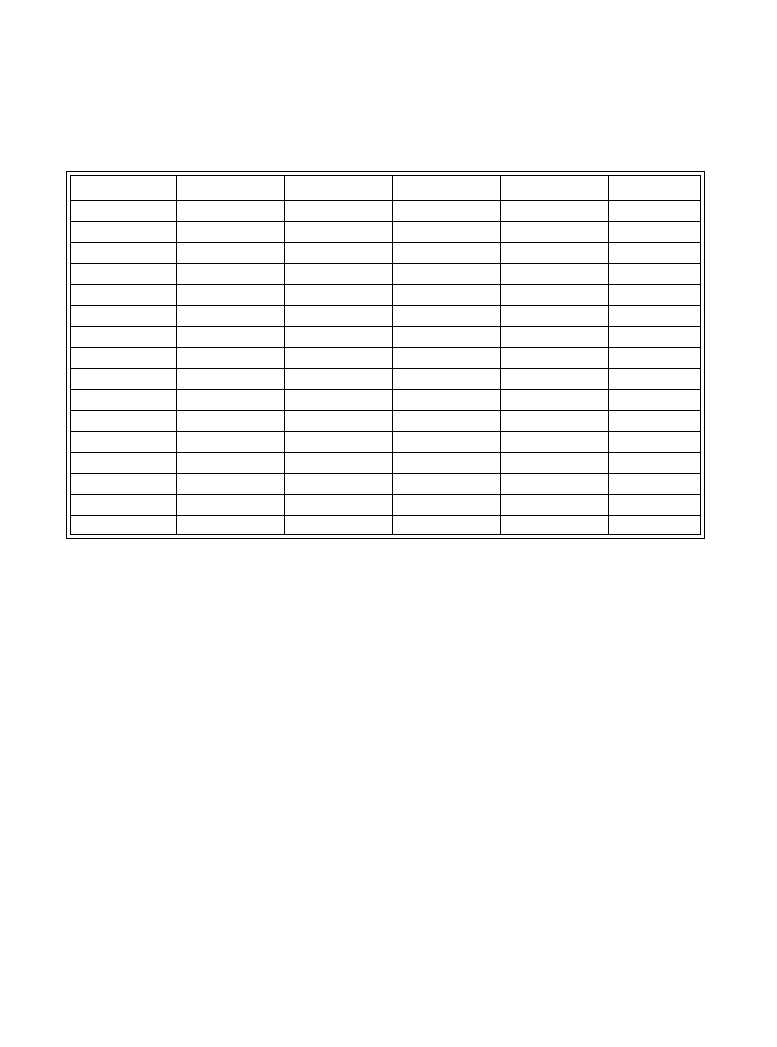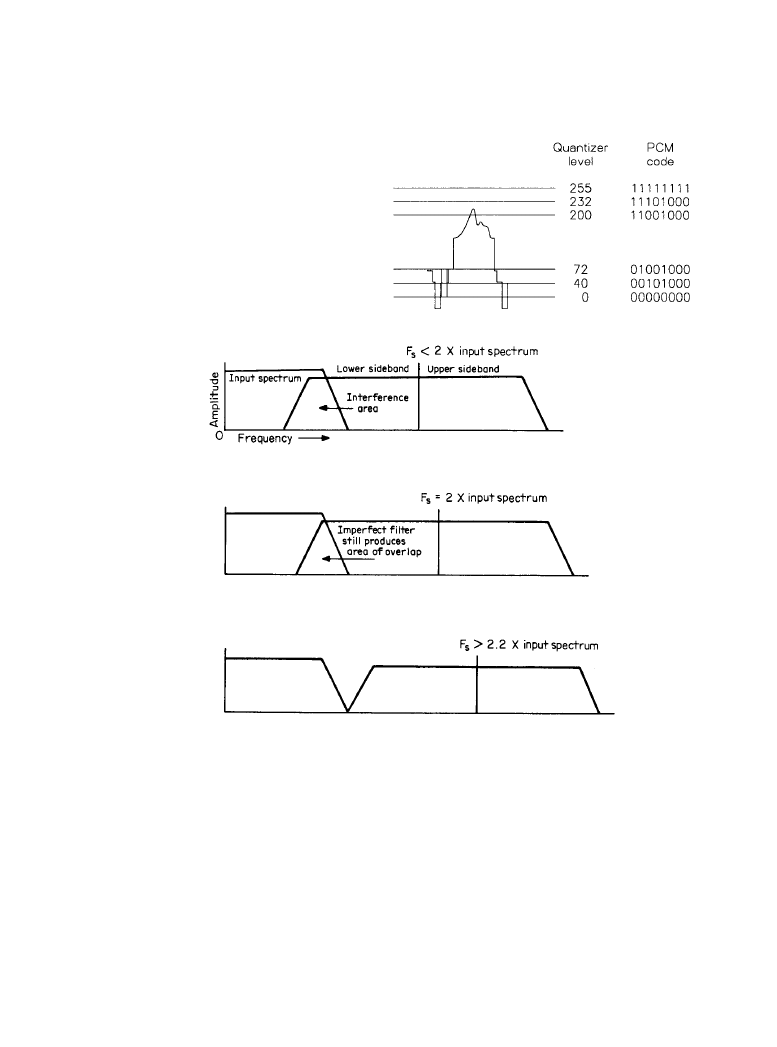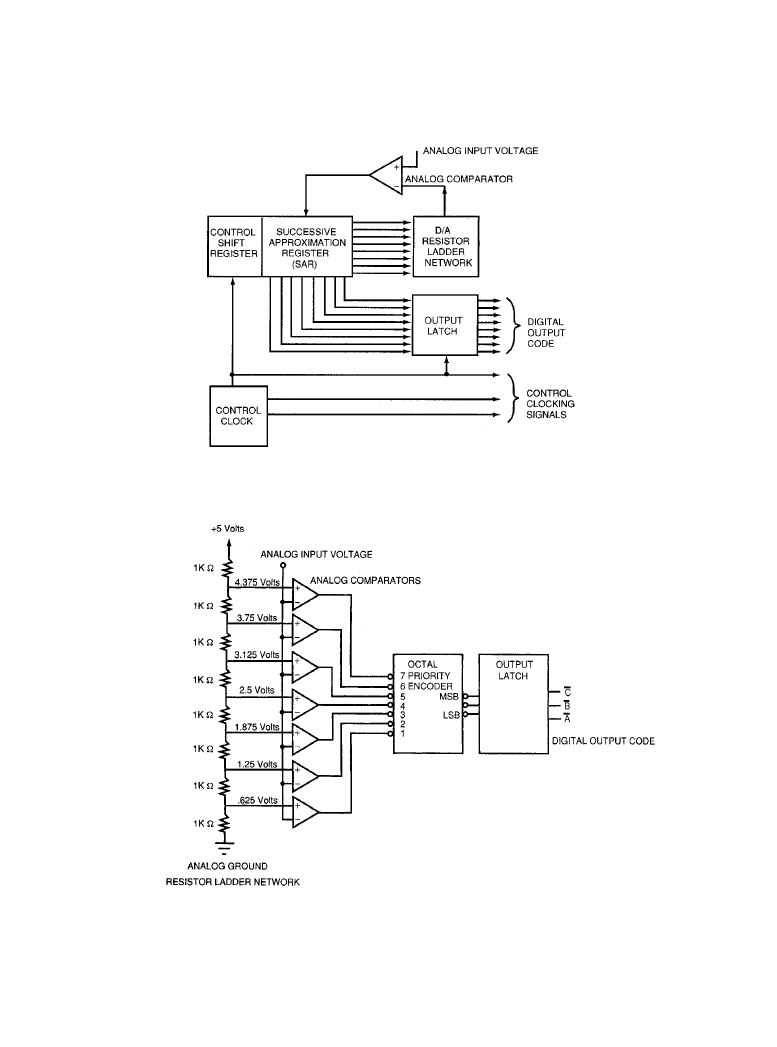ВУЗ: Казахская Национальная Академия Искусств им. Т. Жургенова
Категория: Книга
Дисциплина: Не указана
Добавлен: 03.02.2019
Просмотров: 21681
Скачиваний: 19

6-6 Digital Coding of Audio Signals
can be applied to a signal having no higher frequency components than 6.75 MHz. If studio
equipment exceeds this limit—and many cameras and associated amplifiers do—a low-pass fil-
ter must be inserted in the signal path before the conversion from analog to digital form takes
place. A similar band limit must be met at 3.375 MHz in the chrominance channels before they
are digitized in the NTSC system. If the sampling occurs at a rate lower than the Nyquist limit,
the spectrum of the output analog signal contains spurious components, which are actually
higher-frequency copies of the input spectrum that have been transposed so that they overlap the
desired output spectrum. When this output analog signal is displayed, the spurious information
shows up in a variety of forms, depending on the subject matter and its motions [1]. Moiré pat-
terns are typical, as are distorted and randomly moving diagonal edges of objects. These aliasing
effects often cover large areas and are visible at normal viewing distances.
Aliasing may occur, in fact, not only in digital sampling, but whenever any form of sampling
of the image occurs. An example long familiar in motion pictures is that of vehicle wheels (usu-
ally wagon wheels) that appear to be rotating backward as the vehicle moves forward. This
occurs because the image is sampled by the camera at 24 frames/s. If the rotation of the spokes of
the wheel is not precisely synchronous with the film advance, another spoke takes the place of
the adjacent one on the next frame, at an earlier time in its rotation. The two spokes are not sepa-
rately identified by the viewer, so the spoke motion appears reversed. Many other examples of
image sampling occur in television. The display similarly offers a series of samples in the verti-
cal dimension, with results that depend not only on the time-vs.-light characteristics of the dis-
play device but also, and more important, on the time-vs.-sensation properties of the human eye.
6.1.3
The A/D Conversion Process
To convert a signal from the analog domain into a digital form, it is necessary to create a succes-
sion of digital words that comprise only two discrete values, 0 and 1 [1]. Figure 6.1.1 shows the
essential elements of the analog-to-digital converter. The input analog signal must be confined to
a limited spectrum to prevent spurious components in the reconverted analog output. A low-pass
filter, therefore, is placed prior to the converter. The converter proper first samples the analog
input, measuring its amplitude at regular, discrete intervals of time. These individual amplitudes
then are matched, in the quantizer, against a large number of discrete levels of amplitude (256
levels to convert into 8-bit words). Each one of these discrete levels can be represented by a spe-
cific digital word. The process of matching each discrete amplitude with its unique word is car-
ried out in the encoder, which, in effect, scans the list of words and picks out the one that matches
Figure 6.1.1
Basic elements of an analog-to-digital converter. (
From [1]. Used with permission.)
Downloaded from Digital Engineering Library @ McGraw-Hill (www.digitalengineeringlibrary.com)
Copyright © 2004 The McGraw-Hill Companies. All rights reserved.
Any use is subject to the Terms of Use as given at the website.
Analog/Digital Signal Conversion

Analog/Digital Signal Conversion 6-7
the amplitude then present. The encoder passes out the series of code words in a sequence corre-
sponding to the sequence in which the analog signal was sampled. This bit stream is, conse-
quently, the digital version of the analog input.
The list of digital words corresponding to the sampled amplitudes is known as a code. Table
6.1.1 represents a simple code showing amplitude levels and their 8-bit words in three ranges: 0
to 15, 120 to 135, and 240 to 255. Signals encoded in this way are said to be pulse-code-modu-
lated. Although the basic pulse-code modulation (PCM) code sometimes is used, more elaborate
codes—with many additional bits per word—generally are applied in circuits where errors may
be introduced into the bit stream. Figure 6.2.2 shows a typical video waveform and several quan-
tized amplitude levels based on the PCM coding scheme of Table 6.1.1.
The sampling rate, even in analog sampling systems, is crucial. Figure 6.1.3a shows the spec-
tral consequence of a sampling rate that is too low for the input bandwidth; Figure 6.1.3b shows
the result of a rate equal to the theoretical minimum value, which is impractical; and Figure
6.1.3c shows typical practice. The input spectrum must be limited by a low-pass filter to greatly
attenuate frequencies near one-half the sampling rate and above. The higher the sampling rate,
the easier and simpler the design of the input filter becomes. An excessively high sampling rate,
however, is wasteful of transmission bandwidth and storage capacity, while a low but adequate
rate complicates the design and increases the cost of input and output analog filters.
Analog signals can be converted to digital codes using a number of methods, including the
following [3]:
Table 6.1.1 Binary Values of Amplitude Levels for 8-Bit Words
(
From [1]. Used with permis-
sion.)
Amplitude
Binary Level
Amplitude
Binary Level
Amplitude
Binary Level
0
00000000
120
01111000
240
11110000
1
00000001
121
01111001
241
11110001
2
00000010
122
01111010
242
11110010
3
00000011
123
01111011
243
11110011
4
00000100
124
01111100
244
11110100
5
00000101
125
01111101
245
11110101
6
00000110
126
01111110
246
11110110
7
00000111
127
01111111
247
11110111
8
00001000
128
10000000
248
11111000
9
00001001
129
10000001
249
11111001
10
00001010
130
10000010
250
11111010
11
00001011
131
10000011
251
11111011
12
00001100
132
10000100
252
11111100
13
00001101
133
10000101
253
11111101
14
00001110
134
10000110
254
11111110
15
00001111
135
10000111
255
11111111
Downloaded from Digital Engineering Library @ McGraw-Hill (www.digitalengineeringlibrary.com)
Copyright © 2004 The McGraw-Hill Companies. All rights reserved.
Any use is subject to the Terms of Use as given at the website.
Analog/Digital Signal Conversion

6-8 Digital Coding of Audio Signals
•
Integration
•
Successive approximation
•
Parallel (flash) conversion
Figure 6.1.2
Video waveform quan-
tized into 8-bit words.
(
a)
(
b)
(
c)
Figure 6.1.3
Relationship between sampling rate and bandwidth: (
a) a sampling rate too low for
the input spectrum, (
b) the theoretical minimum sampling rate (F
s
), which requires a theoretically
perfect filter, (
c) a practical sampling rate using a practical input filter.
Downloaded from Digital Engineering Library @ McGraw-Hill (www.digitalengineeringlibrary.com)
Copyright © 2004 The McGraw-Hill Companies. All rights reserved.
Any use is subject to the Terms of Use as given at the website.
Analog/Digital Signal Conversion

Analog/Digital Signal Conversion 6-9
•
Delta modulation
•
Pulse-code modulation
•
Sigma-delta conversion
Two of the more common A/D conversion processes are successive approximation and parallel
or flash. Very high-resolution digital video systems require specialized A/D techniques that often
incorporate one of these general schemes in conjunction with proprietary technology.
6.1.3a
Successive Approximation
Successive approximation A/D conversion is a technique commonly used in medium- to
high-speed data-acquisition applications. One of the fastest A/D conversion techniques, it
requires a minimum amount of circuitry to implement. The conversion times for successive
approximation A/D conversion typically range from 10 to 300
µs for 8-bit systems.
The successive approximation A/D converter can approximate the analog signal to form an
n-bit digital code in n steps. The successive approximation register (SAR) individually compares
an analog input voltage with the midpoint of one of n ranges to determine the value of 1 bit. This
process is repeated a total of n times, using n ranges, to determine the n bits in the code. The
comparison is accomplished as follows:
•
The SAR determines whether the analog input is above or below the midpoint and sets the bit
of the digital code accordingly.
•
The SAR assigns the bits beginning with the most significant bit.
•
The bit is set to a 1 if the analog input is greater than the midpoint voltage; it is set to a 0 if the
input is less than the midpoint voltage.
•
The SAR then moves to the next bit and sets it to a 1 or a 0 based on the results of comparing
the analog input with the midpoint of the next allowed range.
Because the SAR must perform one approximation for each bit in the digital code, an n-bit code
requires n approximations. A successive approximation A/D converter consists of four main
functional blocks, as shown in Figure 6.1.4. These blocks are the SAR, the analog comparator, a
D/A (digital-to-analog) converter, and a clock.
6.1.3b
Parallel/Flash
Parallel or flash A/D conversion is used in high-speed applications such as video signal process-
ing, medical imaging, and radar detection systems. A flash A/D converter simultaneously com-
pares the input analog voltage with 2
n
– 1 threshold voltages to produce an n-bit digital code
representing the analog voltage. Typical flash A/D converters with 8-bit resolution operate at 100
MHz to 1 GHz.
The functional blocks of a flash A/D converter are shown in Figure 6.1.5. The circuitry con-
sists of a precision resistor ladder network, 2
n
– 1 analog comparators, and a digital priority
encoder. The resistor network establishes threshold voltages for each allowed quantization level.
The analog comparators indicate whether the input analog voltage is above or below the thresh-
old at each level. The output of the analog comparators is input to the digital priority encoder.
The priority encoder produces the final digital output code, which is stored in an output latch.
Downloaded from Digital Engineering Library @ McGraw-Hill (www.digitalengineeringlibrary.com)
Copyright © 2004 The McGraw-Hill Companies. All rights reserved.
Any use is subject to the Terms of Use as given at the website.
Analog/Digital Signal Conversion

6-10 Digital Coding of Audio Signals
Figure 6.1.4
Successive approximation A/D converter block diagram. (
After [4].)
Figure 6.1.5
Block diagram of a flash A/D converter. (
After [5].)
Downloaded from Digital Engineering Library @ McGraw-Hill (www.digitalengineeringlibrary.com)
Copyright © 2004 The McGraw-Hill Companies. All rights reserved.
Any use is subject to the Terms of Use as given at the website.
Analog/Digital Signal Conversion